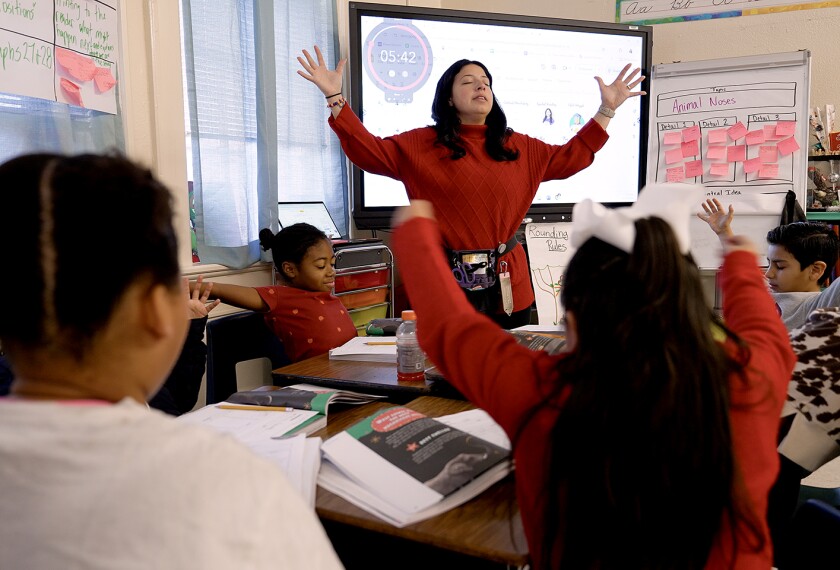There is arguably no job more important to a 1st grader than that of line leader. The coveted job—whether formally assigned or not—ensures a first-place spot in the line. For many early-elementary students, this position is too enticing to resist.
Recently, while redirecting two of my students who had physically pushed past others to secure this spot, I realized that “line leader” is likely one of the first contexts where students hear the word “leader.” Consequently, many associate leadership with being first. This association then informs an inaccurate understanding of leadership in young learners.
I wanted to make a point of highlighting the qualities that make someone a leader other than just being first. The problem, however, is that leadership skills for elementary students often get lumped into social-emotional learning and social-skills curricula. While all these skills can look similar in young kids, being able to regulate emotions and exhibit leadership qualities are very different. In fact, making this distinction clear to students and explicitly teaching leadership skills can be a crucial component of shaping young leaders.
We don’t teach leadership skills enough to early-elementary students. If you’re thinking, “But I never have time for that!” or “There are far too many other pressing skills to teach,” you’re right—but that’s exactly the point. Leadership skills often get sidelined in the early grades and overshadowed by social-emotional skills and academics. While those areas are certainly important, casting leadership aside isn’t helpful.
In SEL and social-skills lessons, we teach students to talk about their feelings and think of how they can productively foster relationships with others. Curricula like Fly Five and Second Step provide students with strategies for implementing these skills in daily life.
However, when Rachel Simmons, an author and speaker on female leadership, recently came to my school for a professional development session, she warned of a problem with how students learn about feelings. “You don’t learn how to say ‘Hey, I have a problem,’ but you also don’t learn how to hear it,” she explained. “It’s very disconcerting for leadership because it means you don’t talk to each other; you talk about each other.”
In other words, merely talking about feelings and relationships has its place, but learning to explicitly address problems and accept feedback about them is where leadership formation begins. Young students often hear others redirecting them or giving reasons why they can or cannot do something. Instead, teaching them to identify a problem and equipping them with the leadership skills to solve it can be more meaningful over time.
While I am not calling to replace SEL with leadership lessons, I am suggesting that incorporating leadership skills into SEL lessons in elementary school is a disservice. Cultivating effective student leaders in middle and high school—the grades in which leadership typically becomes more of a taught topic—depends on exposure in elementary school.
With these ideas in mind, I set out to craft a mini curriculum for leadership skills in my 1st grade classroom. We started by talking about the words leader and leadership and what they mean. In 1st grade, our working definition identifies a leader as someone who sets the example of doing the right thing even when it’s not what she wants to do or what anyone else is doing. I then implemented a series of small but impactful changes to make the abstract idea of leadership more concrete. Some of the changes include:
1. Reverse line leader—The line leader walks at the end of the line to make sure that everyone stays with the group. This simple shift teaches the importance of leaders putting others first.
2. Circle of control mapping—My class and I created a visual circle to list things that students can control in the circle. Around the circle, we listed anything we cannot control. When a problem arises, such as a friendship conflict, I encourage students to be a leader by consulting the circle and addressing anything in it. For instance, if the disagreement is over whom to sit next to at lunch, the circle of control can help a student be a leader by choosing to sit somewhere else, thus creating a new option rather than dwelling on the disagreement itself.
3. Neighbor cleanup—Students now help tidy the area of the student sitting next to them rather than their own space. While accountability for one’s own mess has its merits, the idea of servant leadership as well as doing one’s part for the good of the group lends itself well to shaping leadership skills.
4. Setting an example—Once a month, my class collaborates with another class. Some months, my 1st graders read to preschool or kindergarten students, giving them an opportunity to lead younger students in a reading activity. Other months, we visit an older class so that 1st graders can see older students leading them through a lesson. For instance, we have had 7th graders teach a culminating social studies lesson for a unit and worked with 5th graders on a STEM—science, technology, engineering, math—activity. Collaborating with different grade levels allows students an opportunity to set an example and learn from students of varying ages.
After just weeks of putting these ideas into practice, I began to notice my students taking more initiative on their own, practicing problem-solving skills before seeking help, and more readily helping their classmates instead of simply pointing out a problem.
We still conduct social-skills lessons and weave SEL into our day, but by learning leadership skills, my students have grown to naturally practice emerging leadership skills that will equip them to become more effective leaders as they progress through school. What’s more, it makes our classroom community function more efficiently as students can draw on leadership skills to face challenges and disappointment.





